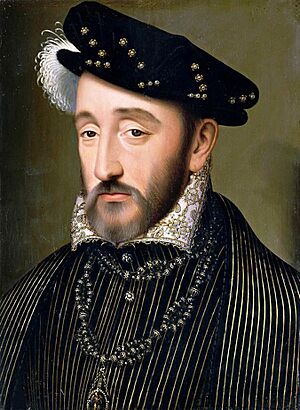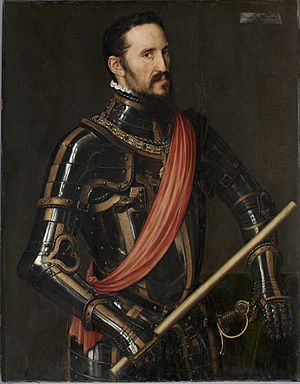Siege of Perpignan (1542) facts for kids
Quick facts for kids Siege of Perpignan |
|||||||
|---|---|---|---|---|---|---|---|
| Part of the Italian War of 1542–1546 | |||||||
|
|||||||
| Belligerents | |||||||
| Commanders and leaders | |||||||
| Dauphin of France | Duke of Alba | ||||||
| Strength | |||||||
| 40,000 men | Unknown | ||||||
| Casualties and losses | |||||||
| Thousands of dead, sick or wounded |
Unknown, but minor | ||||||
The Siege of Perpignan happened in 1542. It was a big fight between a large French army and the Spanish defenders of Perpignan. The French army was led by Henry, who was the son of the French king. The Spanish soldiers in Perpignan fought bravely. They held out until a Spanish army, led by the Duke of Alba, arrived to help them. This made the French army leave. The siege was a major defeat for Francis I of France, the King of France, during his attacks in 1542.
French Attacks in 1542
In 1541, Francis I of France gathered a lot of power. He made alliances with countries like the Ottoman Empire and Denmark. In July 1542, King Francis declared war. He then sent five French armies to attack the lands of Emperor Charles.
- One army, led by Francis's son Charles, went to Luxembourg.
- Another, led by his oldest son Henry, marched towards Spain.
- Other armies went to places like Brabant, the Netherlands, and Piedmont.
However, these attacks did not go well for King Francis. In Flanders, the French army faced strong defenses. In Piedmont, the French only managed to capture a few towns.
In southern France, the army led by Henry, the king's son, was very large, with 40,000 men. They went to attack Perpignan. But they had wasted time, which Emperor Charles used wisely. He made the towns of Salses, Fuenterrabía, and Perpignan much stronger.
The Siege of Perpignan Begins
Perpignan had been made stronger by the Emperor. Many Spanish nobles and their soldiers, along with hundreds of experienced Spanish fighters, defended the city.
Henry thought it would be an easy win. But he faced very strong resistance. The Spanish defenders, led by Captains Cervellón and Machichaco, made a smart move. They surprised the French attackers. They destroyed most of the heavy French cannons that were damaging the city walls. This was a big setback for the French army.
The French army faced many difficulties. They had hoped for help from the Ottoman Empire, but it never came. Finally, the Spanish army, led by the Duke of Alba, arrived. This forced the French commander, Henry, to stop the attack. The French army had to leave. The siege was a huge loss for the French. Many soldiers died, got sick, or were wounded.
During this siege, a French doctor named Ambroise Paré had a new idea. He was a barber surgeon, meaning he did surgeries and cut hair. A French leader, Maréchal de Brissac, was shot in the shoulder. The bullet was hard to find. Paré asked the injured man to stand in the exact position he was in when he was shot. This helped them find the bullet, and it was removed.
What Happened Next
After the siege, King Francis had not gained much. His efforts had been very costly. He couldn't show off his power in Europe as he had hoped. Both King Francis and Emperor Charles spent the rest of the year getting ready for new battles.
King Francis tried hard to get military help from the Ottoman Empire. He convinced Suleiman the Magnificent to attack areas controlled by Charles of Austria. At the same time, the Ottoman Admiral, Hayreddin Barbarossa, attacked Spanish and Italian coasts.
In Europe, the French army captured some towns. However, the French king strangely stopped his army near Rheims. Meanwhile, Emperor Charles attacked and captured some German towns. The French did capture Luxembourg for a short time. But it was quickly taken back by Emperor Charles's troops.
See also
 In Spanish: Sitio de Perpiñán (1542) para niños
In Spanish: Sitio de Perpiñán (1542) para niños
- Battle of Muros Bay
- Italian Wars
- Franco-Ottoman alliance
- Suleiman the Magnificent
- United Duchies of Jülich-Cleves-Berg




